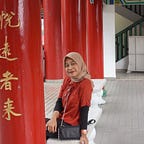Everything is Connected and Useful
Just a mundane story based on my experience about how my field of study helps my UX writing process
I still remember vividly during the first meetings in every new semester, my friends and I were being asked this specific question. “According to Lasswell, what are the elements of communication?” One day in the 4th semester, when a lecturer asked a similar question, the class was suddenly silent.
No one answered until finally, the lecturer appointed a student to answer it. He slowly answered while recalling previous materials taught in the three previous semesters, “Who says what, in which channel, to whom, and with what effect.”
What Lasswell conveyed about it is a fundamental framework to understand the process of one-way communication. During my internship as a UX writer at tiket.com, I used this framework to help me get the work done and understand a project.
I started by asking, “Who?” to know the stakeholders. UX writers seldom work alone; they collaborate with the team and communicate with others related to the project. With that being said, I believe that knowing who gives me the task and who else will be involved in the project is noteworthy.
After questioning that, I continued by asking, “Says what?”. Answering this question helped me grasp the context of the project because, as Steiner said, “To understand is to decipher.” I had to succeed in translating and understanding the project so it would help me later during the whole crafting process.
The question “In which channel?” rarely had different answers because the answer would be the products, most of the time. Nevertheless, sometimes, I modified it by inquiring, “What kind of project is it? For a business purpose or user experience?” This way, I felt more prepared to start the project than before.
In UX writing, the users would be the answer to the question, “To whom?” I occasionally checked the product’s persona and tone of voice during this step. The users are the ones who use the product. While in my field of study, the ones who use the product — news — are the readers, the public. Users are the ‘communicant’ that UX writers, as the ‘communicators’ need to help. So understanding them and what kind of copy will fit is paramount.
Before answering Lasswell’s last question, these two great quotes from when I studied Journalism helped me write. Somehow those words connect my field of study with the world of user experience. The first quotes:
“Put yourself in someone’s shoes.”
Yes, a classic. I’ve been holding on to this mindset since one of my lecturers told me to put myself constantly in the reader’s shoes. I wrote news as a Journalism student, be it hard news or features. I had to be in the position as if I were them and experienced what they have had. Most of the time, I correlate that mindset with the following quote:
“Writers are omniscient, while the readers are clueless.”
I needed to think as if the readers didn’t know anything or were ill-informed. While I, the writer, am all-knowing.
UX writers are responsible for creating clear, concise, and helpful copy for users. If I connect those previous quotes into one, it can help me in this step.
In conclusion, users are ill-informed while I know everything, so I must put myself in users’ shoes to understand them, to be empathetic. That way, applying UX writing principles to my copy crafting process won’t be hard. Personally speaking, clear information and concise wording combined can form useful copy for users.
Besides these mindsets, I ought to know the project’s objectives to answer the last question, “With what effect?”. I need to know the effect we want to give through the project. At tiket.com, I usually look for the ‘How to Communicate’ document if it’s a promo copy. While for any UX copy, reading the PRD (Product Requirements Document) and discussing it with the Product Design team aid to answer that question.
The point is, if we are willing to dig deeper into our field of study, I’m confident there are theories, models, and frameworks we can find to help us get the work done. Apparently, I only remembered the classic Lasswell’s communication model and some lessons in my Journalism classes to be used as my working framework.
To end this story, I quoted a line from Dark Series (2017):
“Everything is connected to everything else.”
And finally.. you are entering my tiket Moments album :”)
